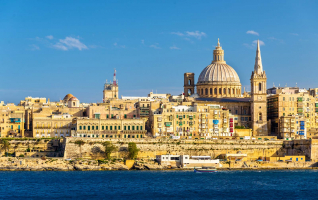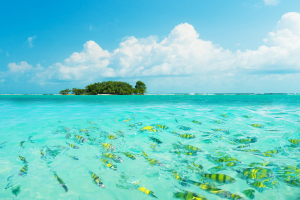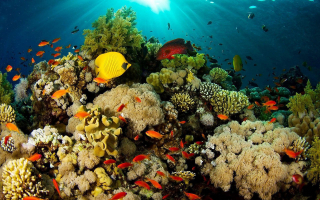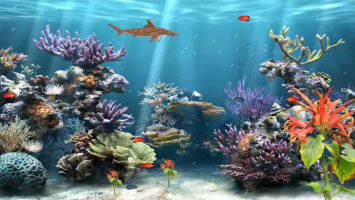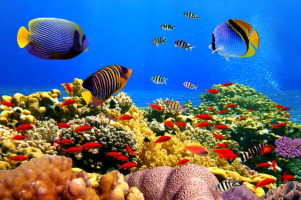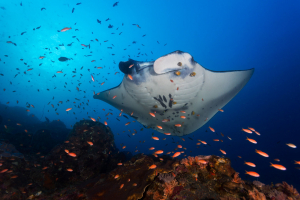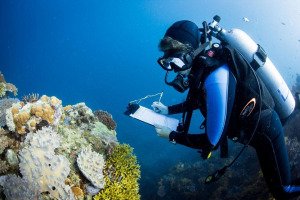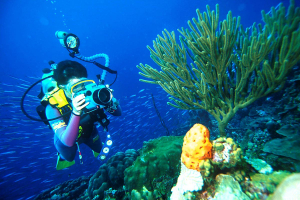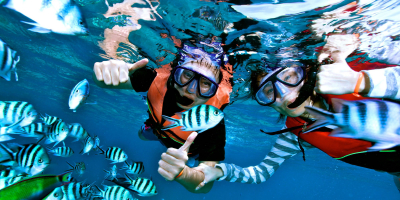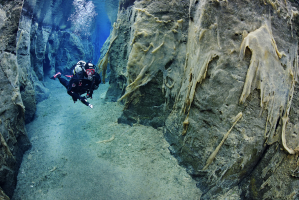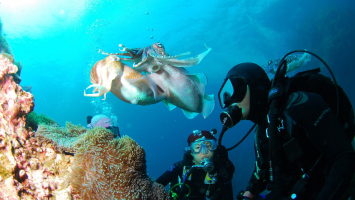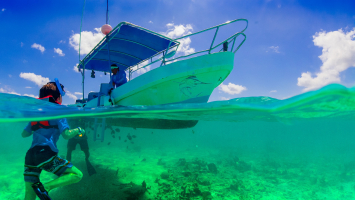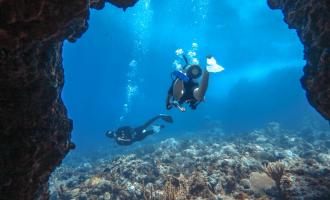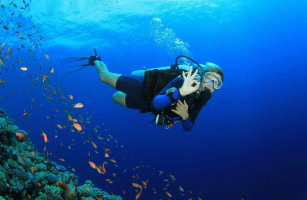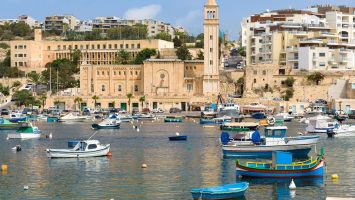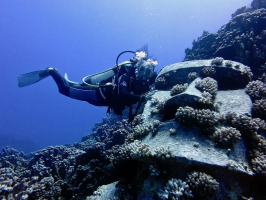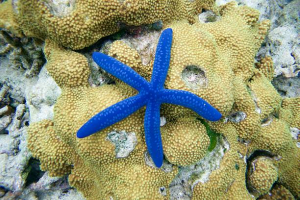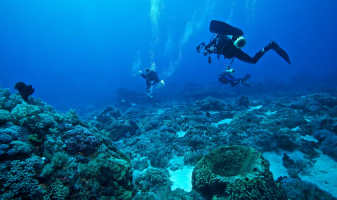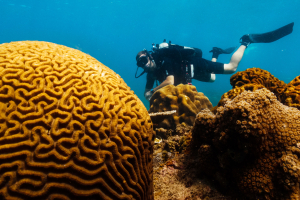Top 10 Most Popular Dive Sites In Malta
According to divers, diving in Malta is a must-see in Europe. There, are some of the best diving spots in the world, for example, wonderful wreck ships and ... read more...extraordinary natural rock formations. In spite of having fewer living species than coral reefs, the Mediterranean Sea still allows divers to spot barracudas, moray eels, groupers, or Nudibranchs. For the luckiest divers, it is also possible to see John Dory fishes St-Pierre, common stingrays, turtles, dolphins, sharks, and even sunfishes. So let's find out the most popular dive sites in Malta!
-
Um El Faroud is the best wreck dive in Malta, at least for recreational divers. MV Um El Faroud was a Libyan oil tanker that was scuttled off the coast of Wied iz-Zurrieq in 1998 as an artificial reef and a scuba diving attraction, after suffering damage in an explosion at the dry docks. The overall length of Um El Faroud is 110 m with a beam of about 16 m. The wreck sits upright on a sandy bottom at the depths of 15 m (the funnel) to 36 m (propeller). The tanker was prepared for diving before scuttling by removing all doors and windows and cutting entry and exit holes for divers. Um El Faroud offers lots of penetration possibilities for experienced wreck divers.
Um El Faroud broke in two during a heavy storm in winter 2005-2006. The two sections have moved so much that the port side of the bow section almost aligns with the starboard side of the stern section and there is a few meters wide gap between them. The heavier stern section has also settled deeper, while the bow section has tilted forwards. Um El Faroud wreck lies parallel to the West Reef, her stern closest to the valley and starboard side towards the reef. The wreck is located approximately 150 m southwest of the entry/exit point in Wied iz-Zurrieq and is usually dived from the shore. Halfway to the wreck is a diving helmet statue as a landmark.
Location: Wied iz-Zurrieq, Malta.
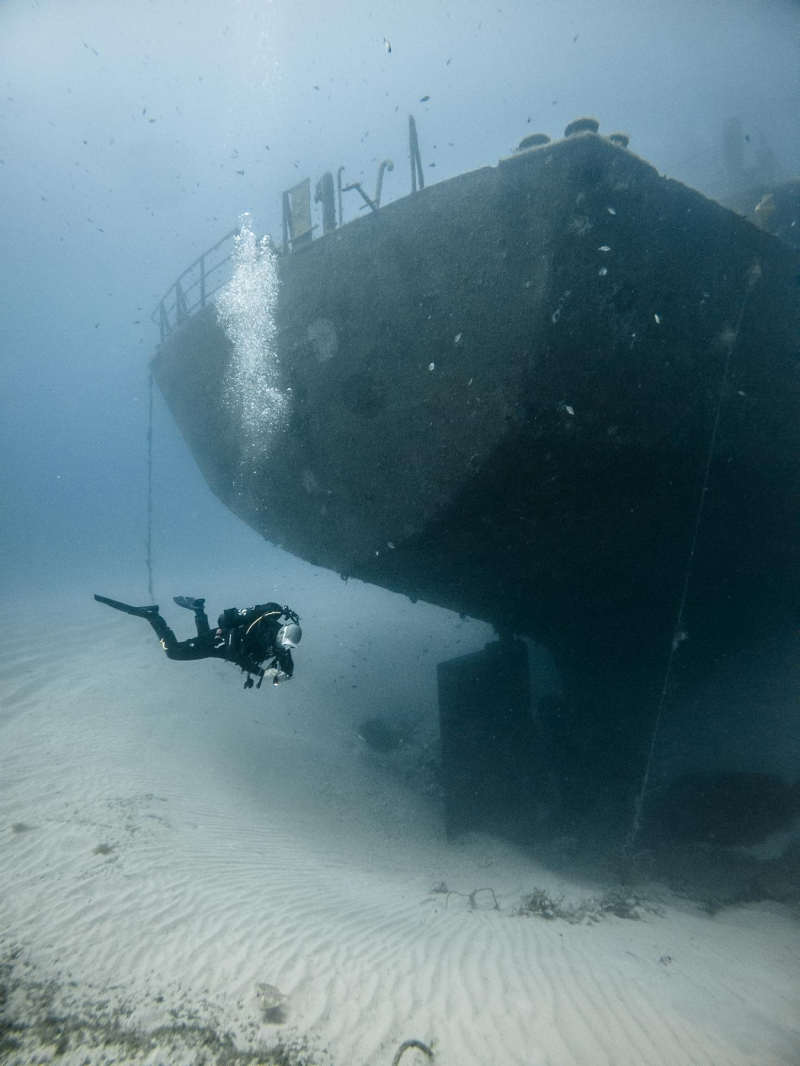
maltadives.com 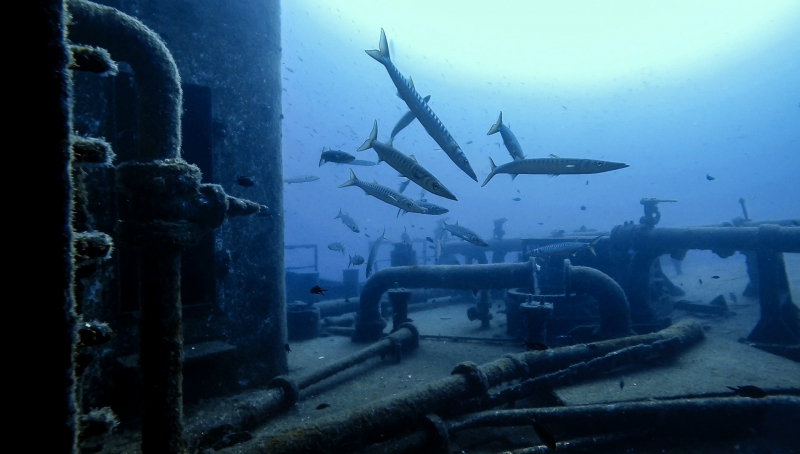
maltadives.com -
MV Karwela is one of the three diving wrecks offshore Xatt l-Ahmar on the south-eastern coast of Gozo. Karwela was a former Captain Morgan Cruises passenger ferry around the Grand Harbour. She was scuttled in August 2006 together with MV Cominoland as an artificial reef for scuba divers. The third wreck MV Xlendi has scuttled already in 1999. Karwela wreck is about 50 m long and is sitting perfectly upright on a sandy bottom with a maximum depth of around 40 m. Her bow lies at 39 m deep, whereas her stern rests at 41 m. The top deck with the captain's cabin starts at depth of 30 m. The wreck is safe to penetrate because of the various openings made before scuttling, and there is plenty to explore on its three decks. Large holes were cut all along the sides of the first two decks, and there is a photogenic staircase in the middle of the wreck leading to the lower deck, which is lit by portholes. There is a small amount of silt and sand inside.
Karwela's bow is approximately 80 m south of the dive’s entry point and about 40 m from the drop-off. She is the middle one of the three wrecks in Xatt l-Ahmar, between Cominoland which lies about 60 m east, and Xlendi about 60 m west of Karwela. All the wrecks are usually dived from the shore but can be done by boat as well. Karwela is probably the most dived wreck around Gozo, as she is more interesting than upturned Xlendi, closer to shore and larger than Cominoland. Shortly after the sinking of Karwela, a Volkswagen Beetle car was also sunk onto her starboard deck by the stern by some local divers, who swam it out on floating barrels. Unfortunately, nothing is left from this car wreck. There is another car wreck near Xlendi in Xatt l-Ahmar though.
Location: Gozo, Malta.
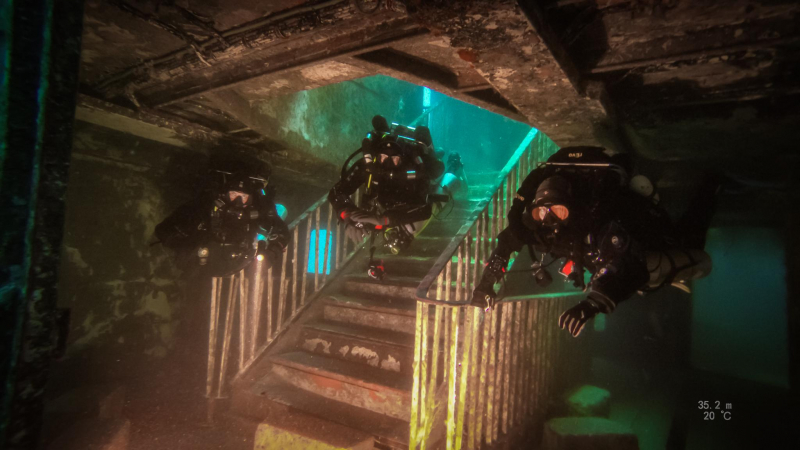
maltadives.com 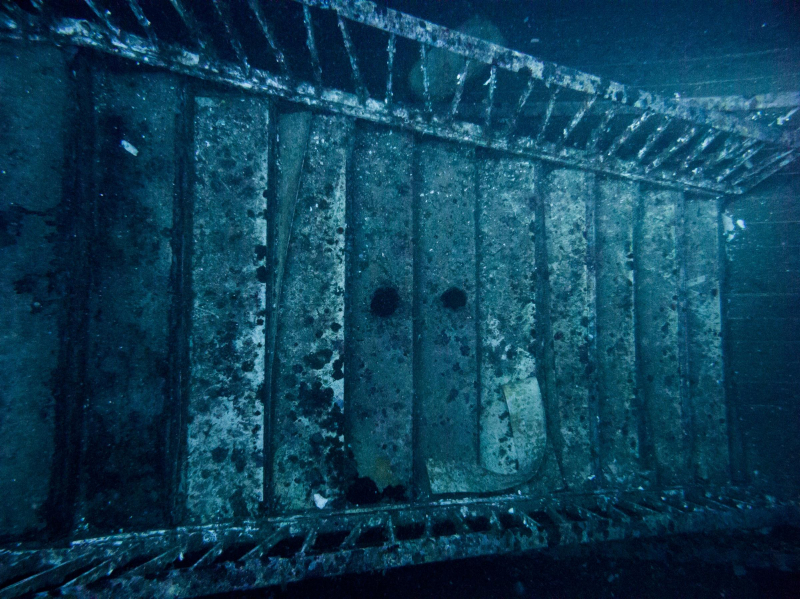
maltadives.com -
Patrol Boat P29 (Boltenhagen) is one of the two wrecks in Cirkewwa and one of the most popular dive sites in Malta. P29 was a former patrol boat for the Maritime Squadron of the Armed Forces of Malta. She was intentionally scuttled in 2007 to serve as a scuba diving attraction and artificial reef. Before scuttling the wreck was made safe both environmentally and for divers. P29 patrol boat lies about 150 m offshore from Cirkewwa and approximately 150 m distance from Tugboat Rozi wreck. P29 wreck is 52 m long and sits upright at a depth of 34 m with the highest part at only 12 m deep from the surface. Many areas were left open for the experienced divers to explore and penetrate the wreck. For divers choosing not to enter P29, there is plenty of marine life to view during exploration of the exterior.
P29 wreck is usually dived from the shore. During the summer season, there is a big yellow buoy marking the wreck. When diving from the shore, either surface swims to the buoy or swims in the midwater. There are two landmarks on the way to make the underwater navigation easier: first a memorial stone on the sand and then an old anchor in the seagrass area. The commemorative plaque is there in memory of a British diver Frank Pembridge. Similar Patrol Boat P31 wreck was scuttled in shallower water off Comino island two years later in 2009.
Location: Cirkewwa, Malta.
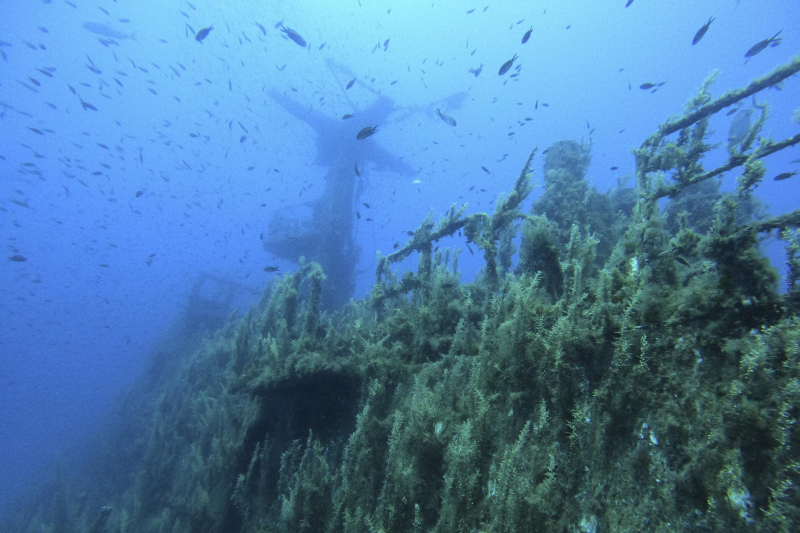
maltadives.com 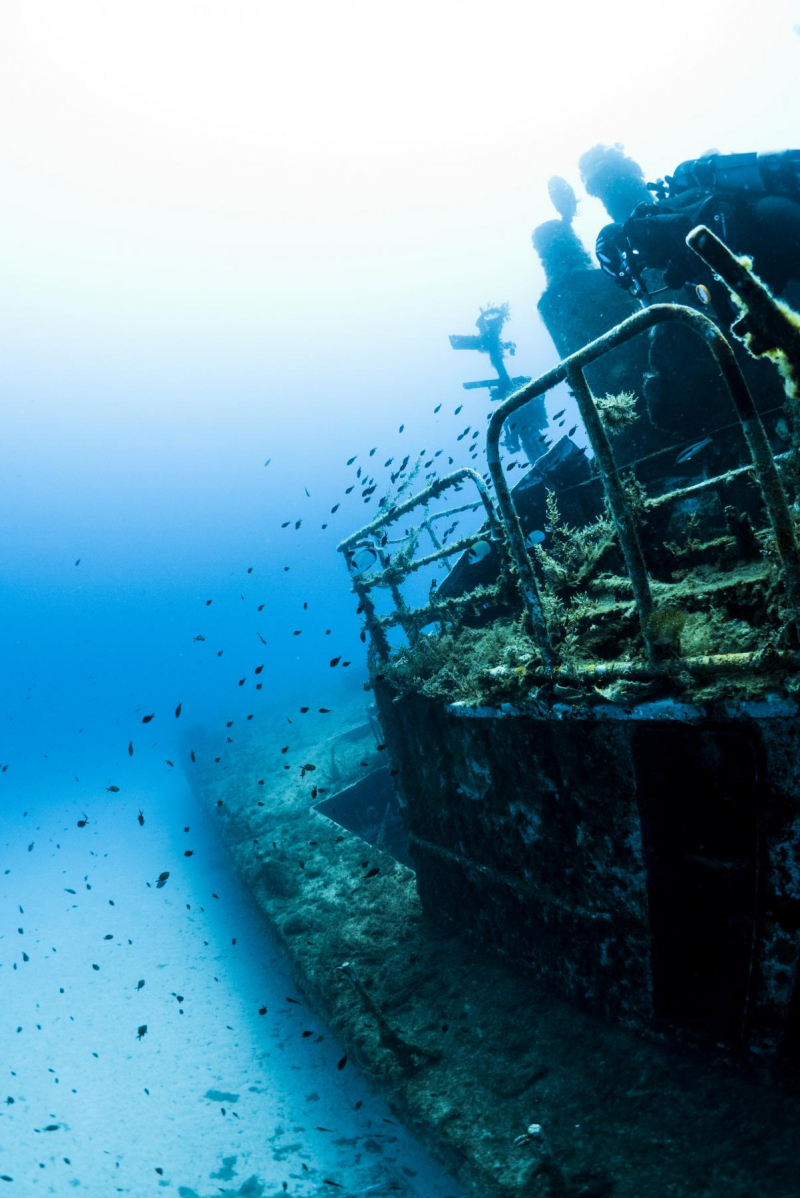
maltadives.com -
Literally one of the best dive spots of Gozo and the most impressive. This rocky promontory is divided into two large arches. The entrance is located in the reef. You can start your dive in shallow water and get to a wall located 14 meters deep. Then you just have to follow the wall until the first arch that appears when you reach 20 meters deep. The second arch is right below and goes until 45 meters. The spot is full of urchins but you can also see cuttlefishes, small octopuses, and scorpionfishes.
Double Arch dive site is located in Marsalforn on the north coast of Gozo. Double Arch has got its name from two natural arches which are built on top of each other. The site is accessible from shore (around a 10-minute dive/surface swim from Xwejni Bay), or by boat. The topmost parts of the reef are at the depths of 15 to 18 m, and the arches start from 20 m deep. Under the arches depth is 34 m and at the end of the reef 45 m. There are also some small caves near the arch and a bigger cave a bit further out. Large shoals of barracudas are often seen near the arch, and sometimes huge groupers in the deeper part.
Location: Gozo, Malta.
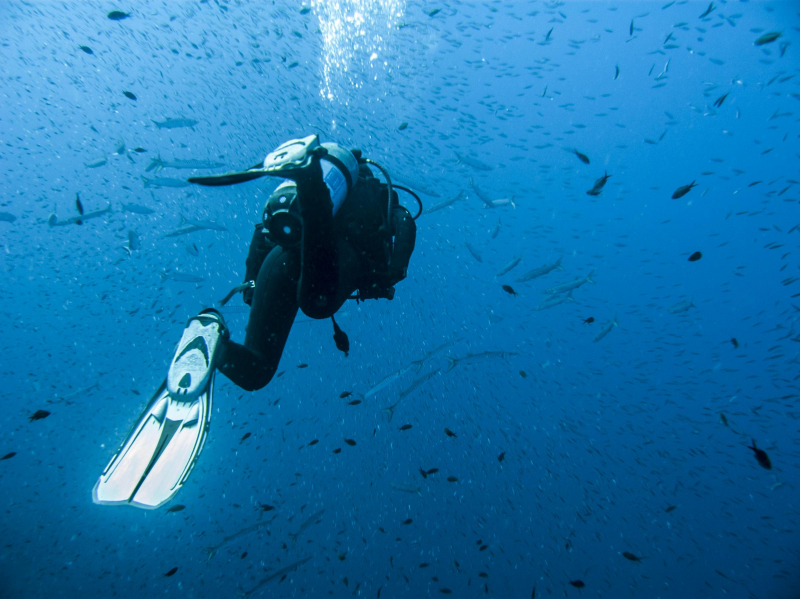
maltadives.com 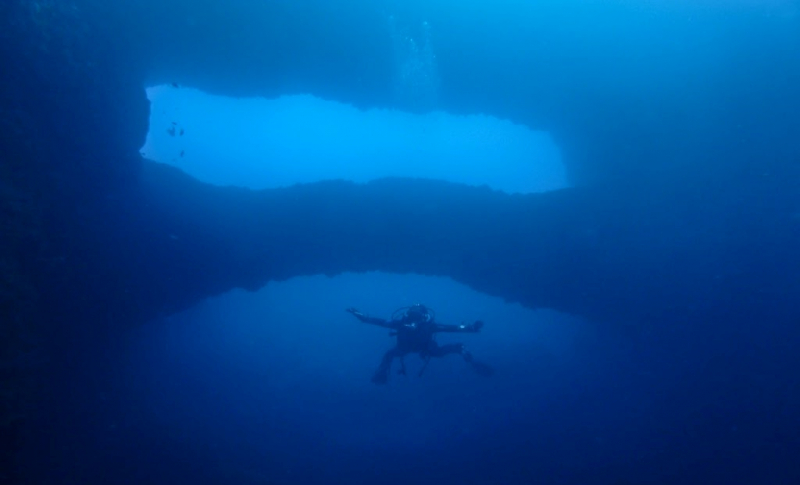
maltadives.com -
Blue Hole in Dwerja is probably the most popular dive sites in Malta, and one of the most beautiful dives on the Maltese Islands. This is a nice place for swimming, snorkeling, and freediving too. Blue Hole is a circular rock formation, a sinkhole in the limestone, about ten meters wide and five meters across. The hole is a sheltered pool as it is protected by a fringe of rock, and divers can safely enter and exit the sea. Blue Hole is often dived in the afternoon when winds start to pick up and other dive sites become more and more inaccessible.
The depth in Blue Hole is about 15 m. A beautiful archway or underwater window leads from the hole into the open sea at 9 m deep. The walls of the hole are covered with colorful coral tubeworms, sponges, and other small marine life. Outside there is a great number of large boulders. On the opposite side of the window, there is a large cave. Blue Hole dive is usually combined with diving Azure Reef (former Azure Window) or Coral Gardens. One can also enter from the Inland Sea and exit through Blue Hole, or vice versa. Blue Hole can be reached after a 200 m hard walk over the rocky shore, but the dive is definitely worth carrying equipment there.Location: Dwerja, Malta.
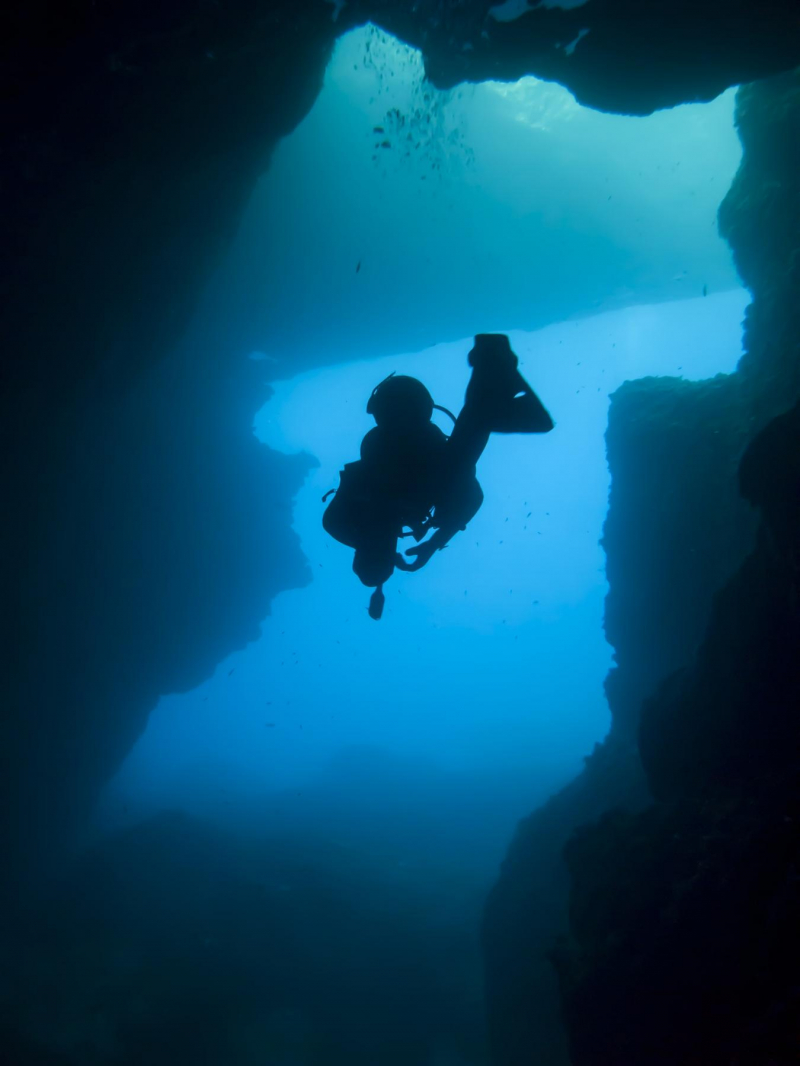
maltadives.com 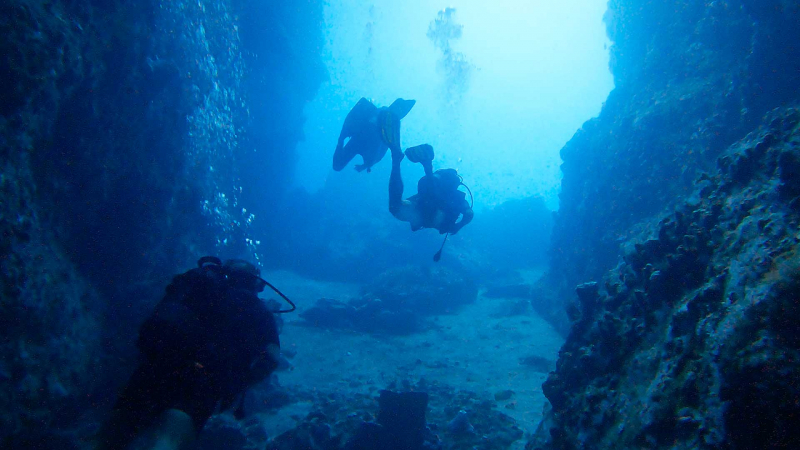
maltadives.com -
Inland Sea & Tunnel is one of the most popular dive sites in Malta. Inland Sea is a shallow semi-circular lagoon about 60 m wide connected to the Mediterranean Sea by an 80 meters long Tunnel cave through the rock. There is actually not much to see for divers in the Inland Sea itself, but the Tunnel offers an amazing diving experience. In the Inland Sea, the maximum depth is 2 meters. The bottom of the Tunnel gets progressively deeper, starting at 3 meters on the lagoon side, and at the seaward end reaching 26 meters. The tunnel has vertical walls and a pebble bottom, ending with a lot of big boulders around the seaside exit. Outside the Tunnel, the seabed drops down to around 50 meters. From the Tunnel, it is possible to either dive the reef walls, north or south of the Tunnel exit, and return to the Inland Sea through the Tunnel, or continue the dive all the way south to Azure Reef and exit through Blue Hole. Towards the north, there are a few caves/cracks to dive, like Whale Cave.
Inland Sea is popular not just with divers but also for tourists looking for boat trips to see the cliffs and caves on Gozo's western coast. It is possible to surface in the tunnel at all times but beware of small motorboats taking tourists on sight-seeing trips during your dive in the tunnel, and stay close to the sides if you have to surface or you are in shallow water.
Location: Dwejra, Malta.
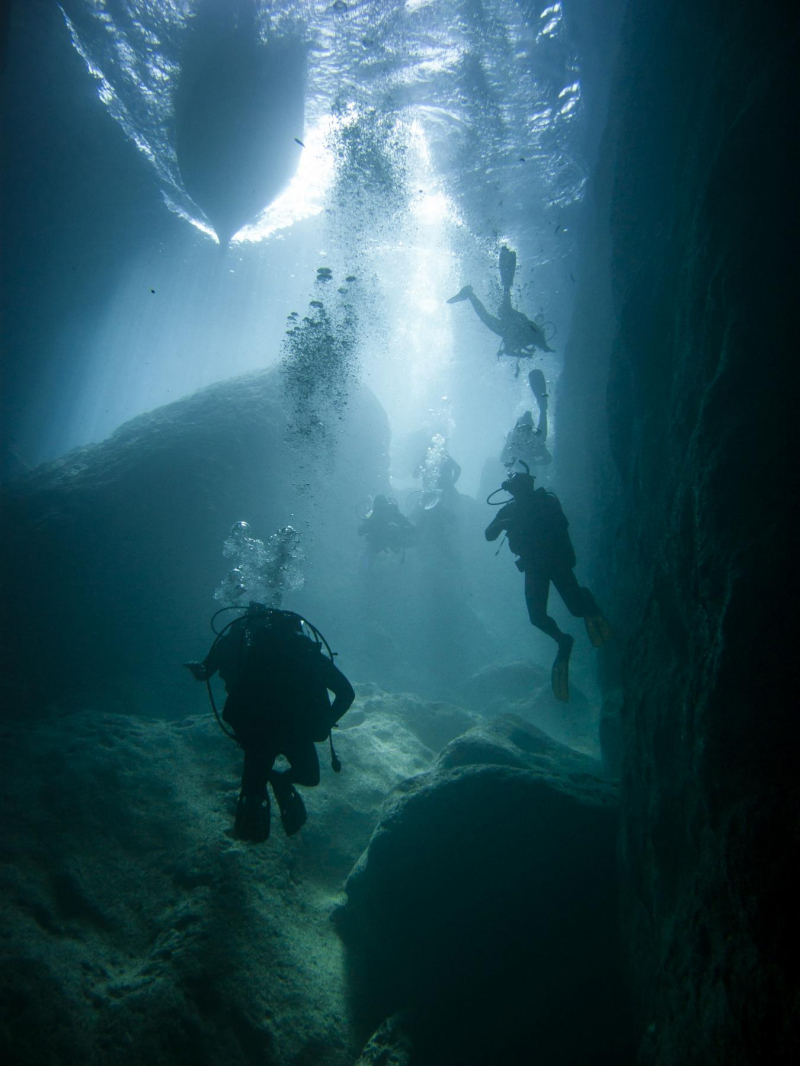
maltadives.com 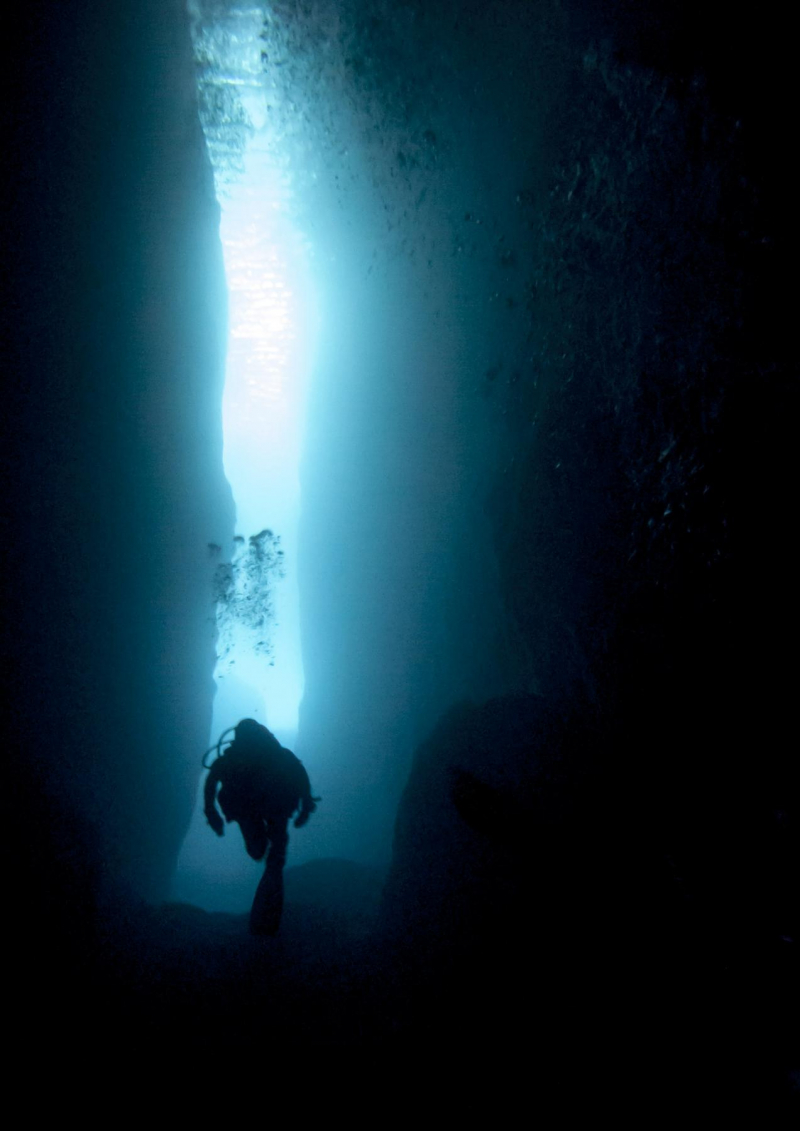
maltadives.com -
Reqqa Point is probably the most popular dive on Gozo’s north coast due to its spectacular underwater topography and abundance of marine life. It is a small pointed headland and lies directly beneath the village of Żebbug, west of the famous Xwejni salt pans. This dive site is susceptible to heavy seas from the prevailing North Westerly winds, but when it is possible to dive there, it has something for all levels of diving. A lovely reef buzzing with life, huge boulders, a submerged chimney or two, a vertical drop off and abundant marine life are some of the features that render this site one of Malta’s best dive sites.
Reqqa reef drops to a depth of 17 meters westward underwater from the left side of the Reqqa point. It is therefore shallow on the left-hand side but deeper to the east where the reef is carved with numerous fissures, inlets, and crevices and leads down to a sandy bottom at 25m. Here divers will savor the site’s biodiversity and the scenic steep Reqqa drop-off with larger and smaller species of fish hunting on and off the reef. More experienced divers could start the dive on the right-hand side and drive westward, descending gradually on the wall to 30 or 40 meters keeping the reef on the left-hand side and following towards the Reqqa reef. The reef drops rapidly to more than 60 meters. Divers dive anti-clockwise towards the reef and start their climb over an area characterized by boulders the size of a house. Back on the top of the reef at an average depth of 15 meters, there are often big shoals of Damselfish and Bogues in "skin-tight" swim formations, which shimmer in the sunlight like silver clouds. Divers then follow up to the shallow part of the reef to start their safety stop and dive on the wall round Reqqa point back to the entry /exit point.Location: Gozo Island, Malta.
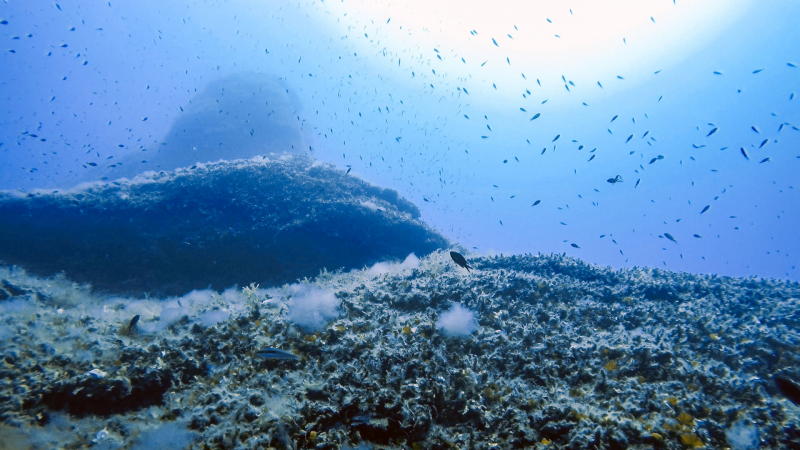
maltadives.com 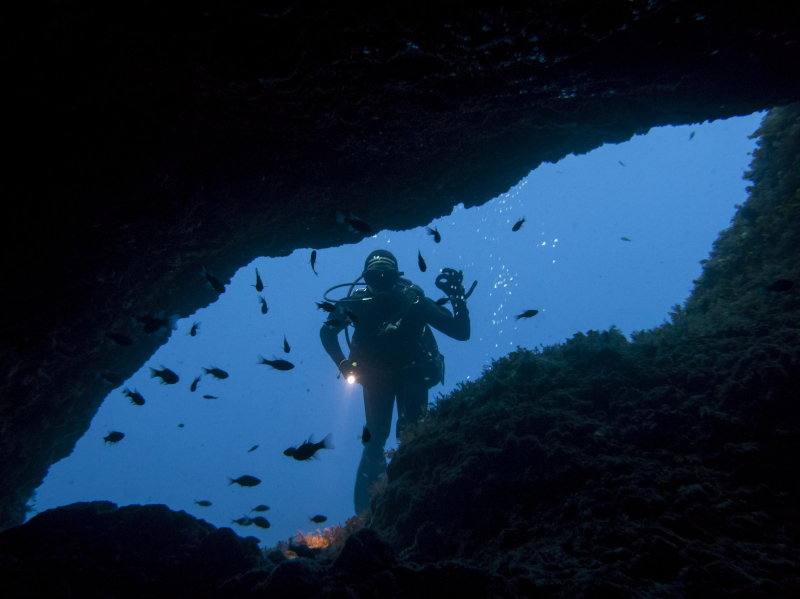
maltadives.com -
Whale Cave is an interesting but less dived crack cave in Dwejra on the west side of Gozo. Whale Cave is located approximately 90-100 m from the seaward exit of Inland Sea’s Tunnel following the reef wall in northerly direction. The seabed is sloping to depths over 40 m, but the cave entrance is at 25 m and about 15 m wide. Whale Cave is not an overhead environment as the crack is open to the surface all the way. The cave reaches about 80 m inwards and gets shallower towards the end. Facing the cave at the bottom, on the right side there is a large rock that divers can swim underneath. On the left side of the cave is a very narrow gap which divers can follow through up to 5 m.
Beware of rough seas, swell and currents as well as small tourist boats making tours in the cave. Whale Cave is also known as Ghar in-Niexef (Cave of Dryness) or Audrey’s Crack. Approximately 100 metres north from Whale Cave is another cave known as Tal-Barba or 200m Tunnel.
Location: Dwejra, Malta.
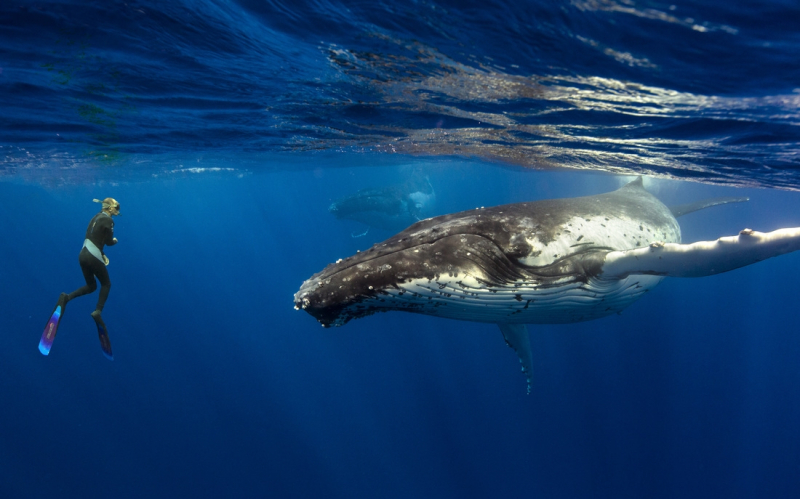
BK Chin 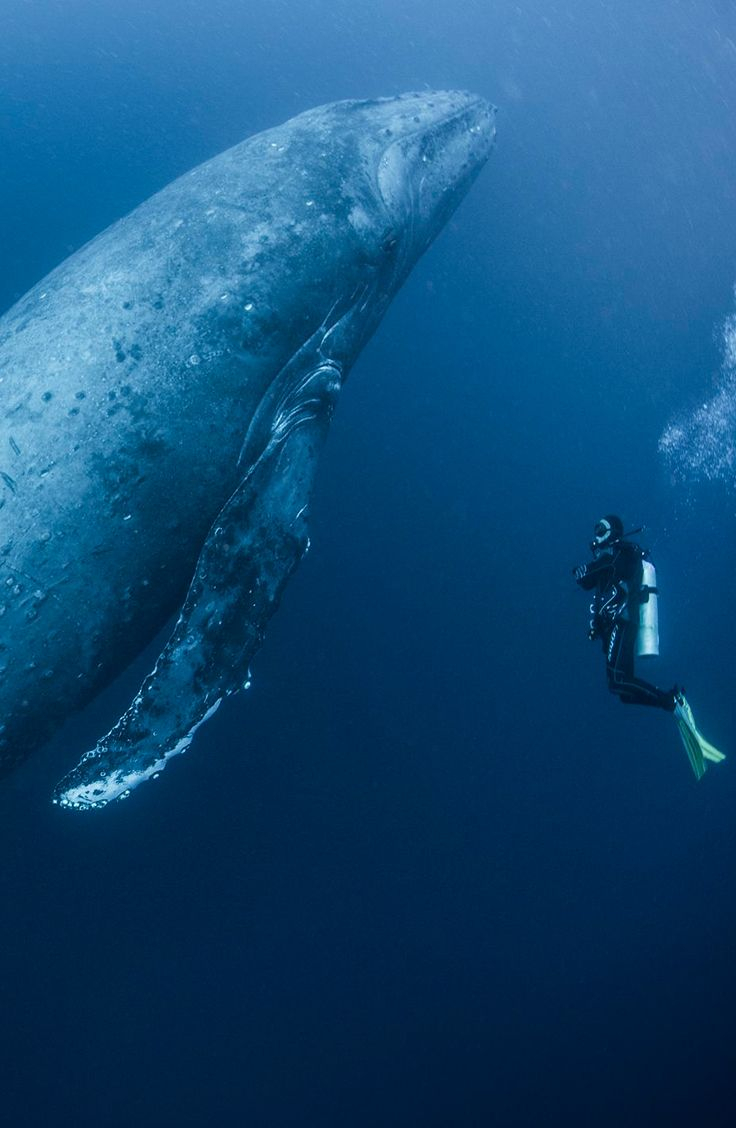
Rodrigo Friscione -
Tal-Barba is an interesting but less dived cave in Dwejra on the west coast of Gozo. Tal-Barba cave is located approximately 200 m from the seaward exit of Inland Sea’s Tunnel following the reef wall in northerly direction. The cave entrance is around 25 m depth and the cave reaches about 120 m inwards. Tal-Barba cave is straight and the exit is always visible. There is also an air pocket in the cave where divers can surface.
Tal-Barba is diveable from the shore, but it’s a very long swim, or using an underwater scooter. Alternatively, divers can rent a small boat from Inland Sea to drop them off outside the cave. As for the return, either have the boat to pick up round the reef, or dive back and visit also Whale Cave around half way to Inland Sea Tunnel. In Maltese, the word 'barba' means beard, and the cave is so named as the shape of the entrance resembles a man’s beard. Tal-Barba cave is also known as 200m Tunnel, although it is actually not 200 metres long.
Location: Dwejra, Malta.
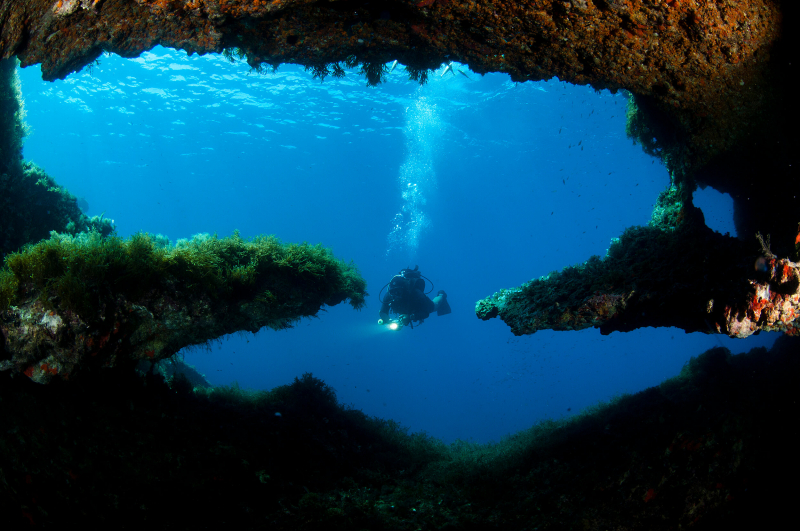
visitgozo.com 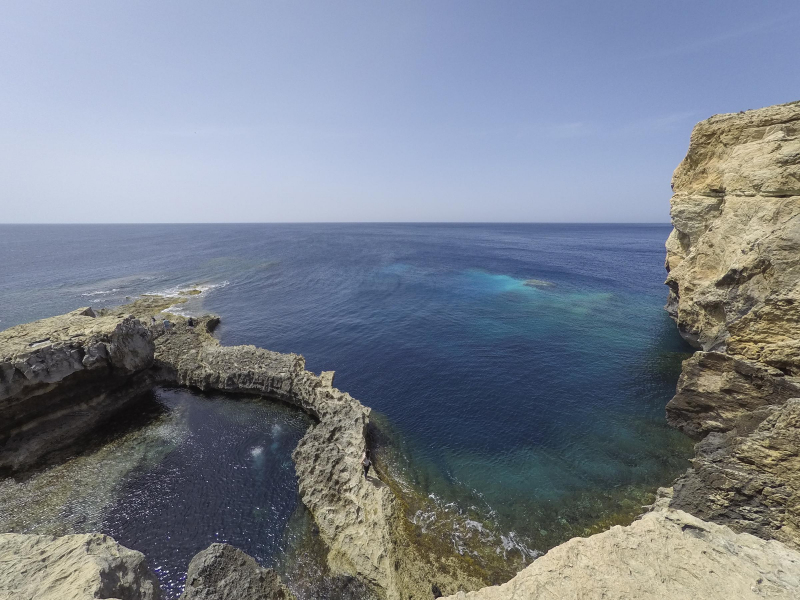
visitgozo.com -
Azure Window in Dwejra, on the west coast of Gozo, collapsed in a heavy storm in March 2017. This formed a new interesting dive site named Azure Reef. Azure Reef starts just below surface and continues to depths over 40 metres. There are huge boulders and sharp edges, mostly barren moonscape, but slowly algae start to grow on the rock and marine life makes the new reef its home. Here and there divers can see plants that were previously growing on the arch above the surface. Below and between the boulders there are swim-throughs, but the rocks could still split and shift so the reef is changing.
A good entry/exit point for Azure Reef dive is through another beautiful dive site, Blue Hole. From the reef divers can continue to nearby Coral Gardens. Azure Window was one of the most famous tourist attractions on Maltese islands. Several large rocks fell off from Azure Window in its final years. Signs warning about walking on the window did not stop tourists. Eventually Azure Window collapsed in a storm on 8th March 2017.
Location: Dwejra, Malta.
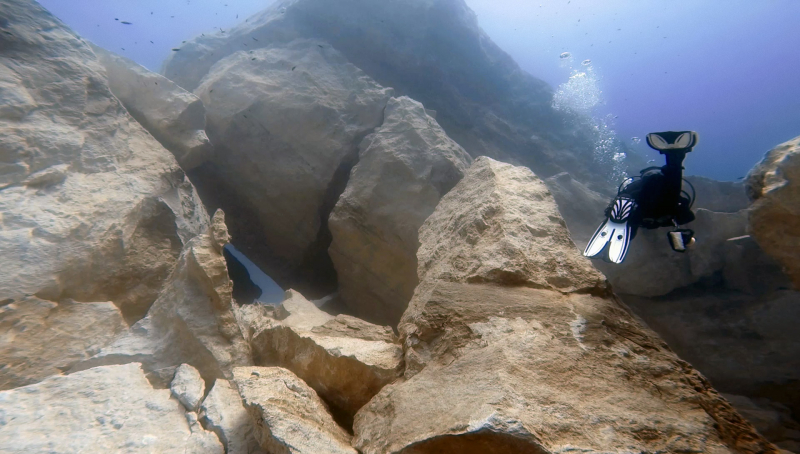
atlantisgozo.com 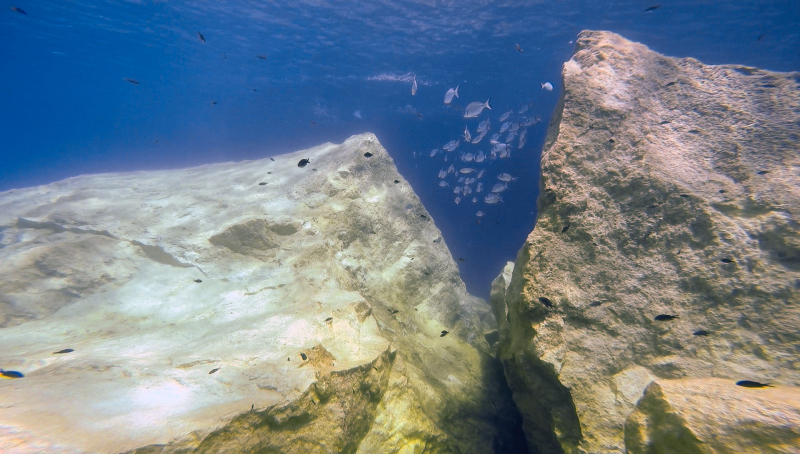
atlantisgozo.com












